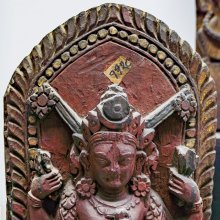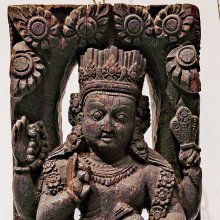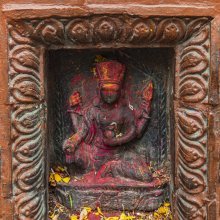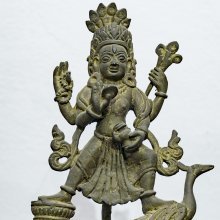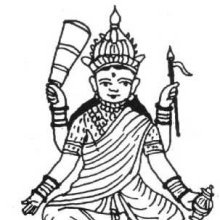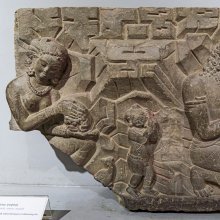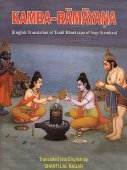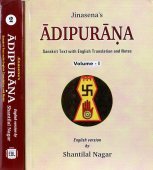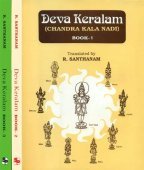Kumara, Kumāra, Kumārā: 48 definitions
Introduction:
Kumara means something in Buddhism, Pali, Hinduism, Sanskrit, Jainism, Prakrit, the history of ancient India, Marathi, Hindi, biology. If you want to know the exact meaning, history, etymology or English translation of this term then check out the descriptions on this page. Add your comment or reference to a book if you want to contribute to this summary article.
Images (photo gallery)
(+12 more images available)
In Hinduism
Shilpashastra (iconography)
Source: Wisdom Library: Elements of Hindu IconograpyKumāra (one of the aspects of Subrahmaṇya, according to the Kumāra-tantra). He should hold in his right hands the śakti and the khaḍga and in the left ones kukkuṭa and the kheṭaka. The Śrītatvanidhi substitutes the abhaya and varada in the place of khaḍga and kheṭaka.
Source: Archaeological Survey of India: Śaiva monuments at Paṭṭadakal (śilpa)Kumāra (कुमार) is depicted as a sculpture in the first pillar of the southern half of the maṇḍapa of the temple of Lokeśvara.—The events leading to the birth of Kumāra, the son of Śiva and Pārvatī have been depicted on the upper portion of all the four façades of this pillar. These pictures are in conformity with the pen pictures that are given in purāṇic texts and in the Kumārasaṃbhava by Kālidāsa.

Shilpashastra (शिल्पशास्त्र, śilpaśāstra) represents the ancient Indian science (shastra) of creative arts (shilpa) such as sculpture, iconography and painting. Closely related to Vastushastra (architecture), they often share the same literature.
Purana and Itihasa (epic history)
Source: Google Books: Cultural History from the Vāyu PurānaKumāra (कुमार):—One of the seven sons of Havya (lord of Śākadvīpa). His varṣa is also called the same: kumāravarṣa.
Source: archive.org: Puranic Encyclopedia1) Kumāra (कुमार).—Skanda or Subrahmaṇya. (For details see under Skanda).
2) Kumāra (कुमार).—A King in ancient India. He was invited by the Pāṇḍavas to help them in the great war. He was defeated by Droṇa. (Udyoga Parva, Chapter 4, Verse 24).
3) Kumāra (कुमार).—A sage reputed as Sanatkumāra. (For details see under Sanatkumāra).
4) Kumāra (कुमार).—One of the prominent sons of Garuḍa.
5) Kumāra (कुमार).—An urban region in ancient India. King Śreṇimān of Kumāra was defeated by Bhīma during his triumphal tour. (Sabhā Parva, Chapter 30, Verse 1).
6) Kumāra (कुमार).—Sanaka, Sanandana, Sanatkumāra and Sanatsujāta were the sons of Brahmā endowed with eternal youthfulness. They are known as the Kumāras.
Source: archive.org: Shiva Purana - English Translation1) Kumāra (कुमार) refers to a “youth”, according to the Śivapurāṇa 2.3.23 (“Attempt of Himavat to dissuade Pārvatī”).—Accordingly, as Himavat said to Pārvatī: “O Pārvatī, O fortunate one, do not torture yourself by this penance. Dear girl, Śiva is not to be seen. Certainly he is detached. You are a young woman of tender limbs [i.e., su-kumāra-aṅgī]. You will be overpowered and exhausted by this penance. There is no doubt about it. I am speaking the truth. Hence, O comely lady, get up. Come back to our house. Of what avail is Śiva by whom Kāma has been reduced to ashes? [...]”.
2) Kumāra (कुमार) (or Guha, Kārttikeya) is the son of Śiva, according to the Śivapurāṇa 2.4.3 (“The boyhood sports of Kārttikeya”).—According to V.S. Agrawal, him Kumāra is the symbol of the life-principle manifesting in every individual. Kṛttikās are the six yogic cakras located in the human body in the golden reed. Kumāra who is born in this six-jointed single reed is called (i) Kārttikeya and (ii) Śākha. The life-principle then branches out in the form of five gross elements and the mind which together are called (iii) Viśākha. As the popular God of the merchant community Kumāra is called (iv) Naigama or Naigameya.
Note: Kumāra is said to be born of Śiva’s semen that was first swallowed by the Fire assuming the form of a pigeon, then by the Kṛttikās, the six wives of the sages, then by Gaṅgā who deposited it in the reeds. Kumāra is thus called “Āgneya, Kārttikeya, Gāṅgeya and Śaraja”.
Source: Cologne Digital Sanskrit Dictionaries: The Purana Index1a) Kumāra (कुमार).—(subrahmaṇya)—born in śarakānana or śaravana and was nursed by the six Kṛttikas, hence Kārttikeya: Sucking milk with six mouths, the child came to be known as Ṣaṇmukha. Appointed commander of the celestial army in the Tārakāsura war and killed Tāraka.1 Śākha, Viśākha and Naigameya were brothers.2 An avatār of Hari.3 A son of Agni through Svāhā, and the son of Gangā by taking Agni's garbha due to Uma's curse. Hence son of Śiva.4 His birth was heralded by divine musicians, siddhas, cāraṇas, yakṣas, kinnaras and others. Fed with milk by the wives of the seven sages except Arundhatī. Hari presented him two birds—fowl and peacock, Sarasvatī the lute, Brāhmī a goat, and Śiva a ram.5 Married Devasenā, the daughter of Indra: also known as Skanda, Guha, and Devasenāpati.6 Mayūra as the riding animal of.7 Wounded by Maya in the battle of Tripuram.8
- 1) Bhāgavata-purāṇa IV. 7. 64-5; Viṣṇu-purāṇa I. 15. 115. Matsya-purāṇa 5. 26-7; 160 (whole): 225. 18; Vāyu-purāṇa 66. 24.
- 2) Ib. 66. 24; Matsya-purāṇa 5. 2617.
- 3) Bhāgavata-purāṇa XI. 4. 17.
- 4) Matsya-purāṇa 135. 79.
- 5) Brahmāṇḍa-purāṇa III. 3. 24; 10. 35. -48; Matsya-purāṇa 203. 6; Vāyu-purāṇa 72. 35-46.
- 6) Brahmāṇḍa-purāṇa IV. 30. 39, 99 to the end; Vāyu-purāṇa 72. 48-50; Brahmāṇḍa-purāṇa III. 10. 48-51.
- 7) Matsya-purāṇa 135. 76.
- 8) Matsya-purāṇa 192. 33.
1b) (Sanat)—a siddha who could not comprehend the supreme Being and who would not find fault with Hara for violating dharma.1 Learnt the bhāgavata from Saṅkarṣaṇa and imparted it to Sānkhyāyana.2
- 1) Bhāgavata-purāṇa VI. 3. 20; 15. 12; 17. 12 and 32; VIII. 23. 20.
- 2) Bhāgavata-purāṇa III. 8. 3 and 7.
1c) A son of Havya, after whom Kumāravarṣa was called.*
- * Brahmāṇḍa-purāṇa II. 14. 17-18; Vāyu-purāṇa 33. 16.
1d) See bhauma.*
- * Brahmāṇḍa-purāṇa II. 23. 85; 28. 92.
1e) A prajāpati.*
- * Brahmāṇḍa-purāṇa III. 1. 54; Vāyu-purāṇa 65. 53.
1f) An author of Architecture.*
- * Matsya-purāṇa 252. 3.
1g) Rose out of the contemplation of Brahmā in the 29th kalpa; with white complexion and a resplendant fearful countenance and mouth; Brahmā worshipped him as the Gods of Gods, purāṇapuruṣa, the best of yogins and laughed a hearty laugh in wonder; also of red colour.*
- * Vāyu-purāṇa 22. 10-23.
1h) At the commencement of the eighth kalpa Brahmā got a son (nīlalohita) who was weeping; he asked Brahmā to give him a name for which Brahmā said rudra; again he cried for a second name and Brahmā said, bhava; the other names given in order were śiva, paśupati, īśa, bhīma, ugra and mahādeva.*
- * Vāyu-purāṇa 27. 4-16.
1i) A Nāga.*
- * Vāyu-purāṇa 69. 71.
1j) A son of Bhavya of Śākadvīpa.*
- * Viṣṇu-purāṇa II. 4. 60.
1k) (c)—a kingdom watered by Hlādinī;1 a tribe.2
1l) A celestial group.*
- * Vāyu-purāṇa 47. 52.
2) Kumārā (कुमारा).—A river from the Śuktimat hill.*
- * Viṣṇu-purāṇa II. 3. 14.
Kumāra (कुमार) is a name mentioned in the Mahābhārata (cf. I.60.22) and represents one of the many proper names used for people and places. Note: The Mahābhārata (mentioning Kumāra) is a Sanskrit epic poem consisting of 100,000 ślokas (metrical verses) and is over 2000 years old.
Kumāra is also mentioned in the Mahābhārata (cf. V.101.15/V.103) and represents one of the many proper names used for people and places.

The Purana (पुराण, purāṇas) refers to Sanskrit literature preserving ancient India’s vast cultural history, including historical legends, religious ceremonies, various arts and sciences. The eighteen mahapuranas total over 400,000 shlokas (metrical couplets) and date to at least several centuries BCE.
Natyashastra (theatrics and dramaturgy)
Source: Wisdom Library: Nāṭya-śāstra1) Kumāra (कुमार) refers to a “prince”, whose beard (śmaśru) should be represented as vicitra (smartly done), according to Nāṭyaśāstra chapter 23. Providing the beard is a component of nepathya (costumes and make-up) and is to be done in accordance with the science of āhāryābhinaya (extraneous representation).
2) Kumāra (कुमार) refers to the role of “princes” defined to the Nāṭyaśāstra chapter 35, the role (bhūmikā) of actors playing princes (kumāras) is defined as, “actors of the best kind who have beautiful eyes, eyebrows, forehead, nose, lips, cheeks, face, neck, and every other limbs beautiful, and who are tall, possessed of pleasant appearance, dignified gait, and are neither fat nor lean, and are well-behaved, wise and steady by nature, should be employed to represent the role of kings (rājan) and princes (kumāra)”.

Natyashastra (नाट्यशास्त्र, nāṭyaśāstra) refers to both the ancient Indian tradition (shastra) of performing arts, (natya—theatrics, drama, dance, music), as well as the name of a Sanskrit work dealing with these subjects. It also teaches the rules for composing Dramatic plays (nataka), construction and performance of Theater, and Poetic works (kavya).
Vyakarana (Sanskrit grammar)
Source: Wikisource: A dictionary of Sanskrit grammar1) Kumāra (कुमार).—Kārtikeya who is believed to havegiven inspiration to the Katantra-sūtrakāra to write the Kātantra-sūtras;
2) Kumāra.—Named Viṣṇumitra who wrote a commentary on the ऋक्प्रातिशाख्य (ṛkprātiśākhya),

Vyakarana (व्याकरण, vyākaraṇa) refers to Sanskrit grammar and represents one of the six additional sciences (vedanga) to be studied along with the Vedas. Vyakarana concerns itself with the rules of Sanskrit grammar and linguistic analysis in order to establish the correct context of words and sentences.
Shaivism (Shaiva philosophy)
Source: Shodhganga: The saurapurana - a critical study (shaivism)Kumāra (कुमार) is another name for Kārttikeya: the son of Śiva, according to the 10th century Saurapurāṇa: one of the various Upapurāṇas depicting Śaivism.—Kārttikeya is also called Skanda, Mahāsena etc.—The birth of Skanda-Kārttikeya is related in chapter sixty two of the Saurapurāṇa. He is frequently mentioned and indeed is more and more brought into the likeness of his father, Śiva. His position as compared with the other gods is significant; Indra foolishy seeks to war with him, but is defeated with humilation. He accepts the Generalship of the divine army and kills Tāraka. Worship of Skanda in Śaiva temples is enjoined in the Saurapurāṇa.

Shaiva (शैव, śaiva) or Shaivism (śaivism) represents a tradition of Hinduism worshiping Shiva as the supreme being. Closely related to Shaktism, Shaiva literature includes a range of scriptures, including Tantras, while the root of this tradition may be traced back to the ancient Vedas.
Vaishnavism (Vaishava dharma)
Source: Pure Bhakti: Brhad BhagavatamrtamKumāra (कुमार) refers to:—Four sages–Sanaka, Sanat, Sanātana and Sanandana–who were the first sons of Brahmā but always appear as children of only five years. They were absorbed in impersonal Brahman but became great devotees of the Lord and authorities on devotional service. (cf. Glossary page from Śrī Bṛhad-bhāgavatāmṛta).

Vaishnava (वैष्णव, vaiṣṇava) or vaishnavism (vaiṣṇavism) represents a tradition of Hinduism worshipping Vishnu as the supreme Lord. Similar to the Shaktism and Shaivism traditions, Vaishnavism also developed as an individual movement, famous for its exposition of the dashavatara (‘ten avatars of Vishnu’).
Shaktism (Shakta philosophy)
Source: Wisdom Library: ŚāktismKumāra (कुमार, “teenager”) refers to one of the sixty defects of mantras, according to the 11th century Kulārṇava-tantra: an important scripture of the Kaula school of Śāktism traditionally stated to have consisted of 125.000 Sanskrit verses.—Accordingly, as Īśvara says to Śrī Devī: “For those who do japa without knowing these defects [e.g., kumāra—teenager], there is no realization even with millions and billions of japa. [...] Oh My Beloved! there are ten processes for eradicating defects in Mantras as described. [...]”.
Source: Google Books: Manthanabhairavatantram1) Kumāra (कुमार) or Kumāraparvata is another name for the Kaumara mountain (identified with Śrīśaila in Andhra) and refers to one of the ten places visited by the Goddess on her pilgrimage, according to Tantric texts such as the Kubjikāmata-tantra, the earliest popular and most authoritative Tantra of the Kubjikā cult.—Accordingly, as the Goddess said: “I am (now) going again there to the Kula mountain in India that has been praised by those who know it as Śrīparvata from ages without beginning. (Also) called (mount) Kumāra, it is adorned with an umbrella for shade”.
2) Kumāra (कुमार) refers to one of the eight Guardians (kṣetrapāla-aṣṭaka) associated with Kāmākhya (corresponding to the eastern face of Bhairava), according to the Manthānabhairavatantra, a vast sprawling work that belongs to a corpus of Tantric texts concerned with the worship of the goddess Kubjikā.—[...] The eight Guardians (kṣetrapālāṣṭaka): Heruka, Kumāra, Kamala, Ṣaṇmukhāntaka, Kadamba, Lalita, Lambodara, Devasena.
3) Kumāra (कुमार) also refers to one of the Siddhas of the Tradition of the Eastern House (pūrvagṛha-āmnāya), according to the Manthānabhairavatantra.

Shakta (शाक्त, śākta) or Shaktism (śāktism) represents a tradition of Hinduism where the Goddess (Devi) is revered and worshipped. Shakta literature includes a range of scriptures, including various Agamas and Tantras, although its roots may be traced back to the Vedas.
Ayurveda (science of life)
Veterinary Medicine (The study and treatment of Animals)
Source: Shodhganga: Portrayal of Animal Kingdom (Tiryaks) in Epics An Analytical studyKumāra (कुमार) (lit. “one who is young”) is a synonym (another name) for Garuḍa, according to scientific texts such as the Mṛgapakṣiśāstra (Mriga-pakshi-shastra) or “the ancient Indian science of animals and birds” by Hamsadeva, containing the varieties and descriptions of the animals and birds seen in the Sanskrit Epics such as the Ramayana and Mahabharata.

Āyurveda (आयुर्वेद, ayurveda) is a branch of Indian science dealing with medicine, herbalism, taxology, anatomy, surgery, alchemy and related topics. Traditional practice of Āyurveda in ancient India dates back to at least the first millenium BC. Literature is commonly written in Sanskrit using various poetic metres.
Vastushastra (architecture)
Source: archive.org: Bharatiya vastu-sastraKumāra (कुमार) is the name of an ancient teacher (ācārya) of Vāstuśāsta (science of architecture) according to the Matsyapurāṇa.—All these great teachers cannot be said to be legendary. Some used to be propagated in ancient India. No nation can flourish without its care for its material prosperity. All this technique and training and their systematic and successful teaching and transmission were of equal importance. Most of the treatises of Vāstuśāstra carry many of these names [i.e., Kumāra], yet a good many of them are quoted as authorities, yet still others are honoured with actual passages being quoted from their works.

Vastushastra (वास्तुशास्त्र, vāstuśāstra) refers to the ancient Indian science (shastra) of architecture (vastu), dealing with topics such architecture, sculpture, town-building, fort building and various other constructions. Vastu also deals with the philosophy of the architectural relation with the cosmic universe.
Jyotisha (astronomy and astrology)
Source: Wisdom Library: Brihat Samhita by VarahamihiraKumāra (कुमार) refers to “boys”, according to the Bṛhatsaṃhitā (chapter 5), an encyclopedic Sanskrit work written by Varāhamihira mainly focusing on the science of ancient Indian astronomy astronomy (Jyotiṣa).—Accordingly, “If there should be both lunar and solar eclipses in one month, princes will suffer both from dissensions among their own army and from wars. [...] If Mars should be eclipsed by Rāhu [—the eclipsed or eclipsing lunar or solar disc as the case may be], the people of Āvanti, those living on the banks of the Kāverī and the Narmada and haughty princes will be afflicted with miseries. If Mercury should be so eclipsed, men living between the Ganges and the Yamunā, on the banks of the Sarayū and in the country of Nepāla, those living about the east sea and on the banks of the Śoṇa will suffer and women, princes, soldier boys [i.e., yodha-kumāra] and men of letters will perish”.

Jyotisha (ज्योतिष, jyotiṣa or jyotish) refers to ‘astronomy’ or “Vedic astrology” and represents the fifth of the six Vedangas (additional sciences to be studied along with the Vedas). Jyotisha concerns itself with the study and prediction of the movements of celestial bodies, in order to calculate the auspicious time for rituals and ceremonies.
Mantrashastra (the science of Mantras)
Source: Wisdom Library: MantrashastraKumāra (कुमार) refers to one of the various mantradoṣa (“defects of mantras”), according to Tantric digests such as the Bṛhattantrasāra (part 4 page 814), Nāradapurāṇa (Nārada-mahā-purāṇa) (verses 64.14-58), Śaradātilaka (verses 2.71-108), Padārthādarśa and Śrīvidyārṇava-tantra.—Kumāra is defined as “mantra consisting of 8 syllables”. [unverified translation!] The Mantra defect elimination methods consist in performing purification rites (saṃskāra).—See Kulārṇava-tantra verse 15.71-2 and Śaradātilaka verse 2.114-22.
Mantrashastra (शिल्पशास्त्र, mantraśāstra) refers to the ancient Indian science of mantras—chants, incantations, spells, magical hymns, etc. Mantra Sastra literature includes many ancient books dealing with the methods reciting mantras, identifying and purifying its defects and the science behind uttering or chanting syllables.
General definition (in Hinduism)
Source: WikiPedia: HinduismKumāra (कुमार): Son of Shiva and Parvati who conquered and slew the demon Taraka.
In Buddhism
Theravada (major branch of Buddhism)
Source: Pali Kanon: Pali Proper Names1. Father of Bharana. He lived in Kappakandara. Mhv.xxiii.64.
2. Name of the god Skanda. He rode on a peacock. It is said that Kumara gave a boon to Manavamma. Cv.lvii.7, 10; see also Hopkins: Epic Mythology, p.227.
Theravāda is a major branch of Buddhism having the the Pali canon (tipitaka) as their canonical literature, which includes the vinaya-pitaka (monastic rules), the sutta-pitaka (Buddhist sermons) and the abhidhamma-pitaka (philosophy and psychology).
Mahayana (major branch of Buddhism)
Source: Wisdom Library: Maha Prajnaparamita SastraKumāra (कुमार) is the name of a deity mentioned in the 2nd century Mahāprajñāpāramitāśāstra (chapter IV). Other individuals also know all the dharmas, e.g., Kieou mo lo (Kumāra): he holds a cock (kukkuṭa), a bell (ghaṇṭā), a red standard (lohitapatākā) and is mounted on a peacock (śikhigata). All these gods are great guides (mahānāyaka). They cannot be omniscient. Why? Because their mind remains attached (abhiniviṣṭa) to hatred (dveṣa) and pride (abhhimāna).

Mahayana (महायान, mahāyāna) is a major branch of Buddhism focusing on the path of a Bodhisattva (spiritual aspirants/ enlightened beings). Extant literature is vast and primarely composed in the Sanskrit language. There are many sūtras of which some of the earliest are the various Prajñāpāramitā sūtras.
Tibetan Buddhism (Vajrayana or tantric Buddhism)
Source: Wisdom Library: Tibetan Buddhism1) Kumāra (कुमार) is the name of a Śrāvaka mentioned as attending the teachings in the 6th century Mañjuśrīmūlakalpa: one of the largest Kriyā Tantras devoted to Mañjuśrī (the Bodhisattva of wisdom) representing an encyclopedia of knowledge primarily concerned with ritualistic elements in Buddhism. The teachings in this text originate from Mañjuśrī and were taught to and by Buddha Śākyamuni in the presence of a large audience (including Kumāra).
2) Kumāra (कुमार) also refers to one of the various Grahas and Mahāgrahas mentioned as attending the teachings in the 6th century Mañjuśrīmūlakalpa.
Source: Brill: Śaivism and the Tantric Traditions (tantric Buddhism)Kumāra (कुमार) refers to a “youth”, according to the Nāmamantrārthāvalokinī by Vilāsavajra, which is a commentary on the Nāmasaṃgīti.—Accordingly, [while describing Ādibuddha]—“[...] He is tranquil, with the ornaments of a youth (kumāra-ābharaṇa-upeta), in fine clothing, wearing about himself a many coloured garment. He has eight arms, holding at his heart with four hands the Śatasāhasrikāprajñāpāramitā divided into four parts, [and] carrying, in each of the other four hands, a sword of wisdom in the gesture of striking. [All this is to be] put in place [i.e. visualised] via the yoga of the four Buddha-thrones”.
Source: OSU Press: Cakrasamvara SamadhiKumāra (कुमार) is the name of a deity, according to the Guru Mandala Worship (maṇḍalārcana) ritual often performed in combination with the Cakrasaṃvara Samādhi, which refers to the primary pūjā and sādhanā practice of Newah Mahāyāna-Vajrayāna Buddhists in Nepal.

Tibetan Buddhism includes schools such as Nyingma, Kadampa, Kagyu and Gelug. Their primary canon of literature is divided in two broad categories: The Kangyur, which consists of Buddha’s words, and the Tengyur, which includes commentaries from various sources. Esotericism and tantra techniques (vajrayāna) are collected indepently.
In Jainism
General definition (in Jainism)
Source: archive.org: The Jaina IconographyKumāra (कुमार) is the name of the Śāsanadeva (Yakṣa) accompanying Vāsupūjya: the twelfth of twenty-four Tīrthaṃkaras or Jinas, commonly depicted in Jaina iconography.—The emblem constantly associated with Vāsupūjya, as wegather from Jaina books, is the buffalo. The other characteristics of his image viz. the Śāsanadeva and the Śāsanadevī are known by the names of Kumāra and Caṇḍā (Digambara: Gāndhārī). The tree which gave him shade while acquiring the Kevala knowledge is Pāṭalika according to the Abhidhānacintāmaṇi and Kadamba according to the Uttarapurāṇa. A King named Darpiṣṭa-Vāsudeva is to wave the Chowri or the fly-fan by his side.
Both the texts of the Śvetāmbaras and the Digambaras coincide in attributing to Kumāra a vehicle of swan and white complexion. The Digambara view makes him three-headed and six-handed while the Śvetāmbara school only four-armed. The attributes held by him according to the former are a bow, ichneumon, fruit, club, vara. The attributes as represented by the latter view are a citrus, arrow, mongoose and bow.
Source: archive.org: TrisastisalakapurusacaritraKumāra (कुमार) is the name of the Yakṣa (or Śāsanadevatās, ‘messenger-deities’) of Vāsupūjya, according to chapter 4.2 [vāsupūjya-caritra] of Hemacandra’s 11th century Triṣaṣṭiśalākāpuruṣacaritra: an ancient Sanskrit epic poem narrating the history and legends of sixty-three illustrious persons in Jainism.
Accordingly:—“Originating in that congregation, a Yakṣa, named Kumāra, whose vehicle was a haṃsa, white, carrying a citron and an arrow in his two right hands, and an ichneumon and a bow in his two left hands, became Vāsupūjya’s messenger-deity. Likewise appeared Candrā, dark colored, with a horse for a vehicle, with one right hand in varada-position and one holding a spear, and with left hands holding a flower and a club, a messenger-deity of the Lord, always near at hand. [...]”.

Jainism is an Indian religion of Dharma whose doctrine revolves around harmlessness (ahimsa) towards every living being. The two major branches (Digambara and Svetambara) of Jainism stimulate self-control (or, shramana, ‘self-reliance’) and spiritual development through a path of peace for the soul to progess to the ultimate goal.
India history and geography
Source: Epigraphia Indica Vol. 36: Tenali plates of eastern Chālukya Vijayāditya I grantKumāra (कुमार) is the name of a garden (ārāma) found witin Triliṅga: an ancient Sanskrit name of the Andhra country, accoriding to verses on the Annavarappāḍu plates of Kāṭaya Vema Reḍḍi. The Reḍḍis (Reddy) were an ancient Telugu dynasty from the 14th century who brought about a golden age of the Andhra country. According to the plates, their captial was named Addaṅki (Addaṃki) which resembled Heaven (Amarāvatī) by the beauty of its horses, the donors and the women. King Vema, son of Anna-bhūpati of the Paṇṭa family, can be identified with Anavema of the inscription at Śrīśaila.
Source: Shodhganga: a concise history of Sanskrit Chanda literature (history)Kumāra (कुमार) was the father of Rūpa Gosvāmin (C. 1470-1583 C.E.): author of Aṣṭādaśachandas and erudite scholar of Indian Diaspora who has enriched the Sanskrit literature by his various compositions with the nectar of Vaiṣṇava philosophy. Rūpagosvāmin was the son of Kumāra, grandson of Mukunda, great grandson of Padmanābha and great great grandson of Rūpeśvara, who is the son of Jagadguru Niruddha. He had two brothers namely Vallabha and Sanātana. He was also the uncle of Jīvagosvāmin, son of his younger brother Vallabha. He was a resident of Rāmakeli, a village in Bengal.
Source: Cologne Digital Sanskrit Dictionaries: Indian Epigraphical GlossaryKumāra.—(IE 8-2; EI 28, 30; BL; HD), designation of a prince or the king's heir-apparent; usually a prince younger than the Yuvarāja (heir-apparent). See CII, Vol. I, pp. 93, 97; Vol. II, pp. 40, 48. Cf. Devī-kumāra (IA 18; CII 1). Note: kumāra is defined in the “Indian epigraphical glossary” as it can be found on ancient inscriptions commonly written in Sanskrit, Prakrit or Dravidian languages.
Source: Institut Français de Pondichéry: The Shaivite legends of KanchipuramKumāra (कुमार) (i.e., Skanda) (in Sanskrit) refers to the Tamil Vēḷ, and represents one of the proper nouns mentioned in the Kanchipuranam, which narrates the Shaivite Legends of Kanchipuram—an ancient and sacred district in Tamil Nadu (India). The Kanchipuranam (mentioning Kumāra) reminds us that Kanchipuram represents an important seat of Hinduism where Vaishnavism and Shaivism have co-existed since ancient times.

The history of India traces the identification of countries, villages, towns and other regions of India, as well as mythology, zoology, royal dynasties, rulers, tribes, local festivities and traditions and regional languages. Ancient India enjoyed religious freedom and encourages the path of Dharma, a concept common to Buddhism, Hinduism, and Jainism.
Biology (plants and animals)
Source: Wisdom Library: Local Names of Plants and DrugsKumara [কুমড়া] in the Bengali language is the name of a plant identified with Cucurbita moschata Duchesne from the Cucurbitaceae (Pumpkin) family having the following synonyms: Cucurbita macrocarpa, Pepo moschata, Cucurbita meloniformis. For the possible medicinal usage of kumara, you can check this page for potential sources and references, although be aware that any some or none of the side-effects may not be mentioned here, wether they be harmful or beneficial to health.
Source: Google Books: CRC World Dictionary (Regional names)1) Kumara in India is the name of a plant defined with Crateva nurvala in various botanical sources. This page contains potential references in Ayurveda, modern medicine, and other folk traditions or local practices It has the synonym Crateva religiosa var. nurvula (Buch.-Ham.) Hook. f. & Thomson (among others).
2) Kumara is also identified with Michelia champaca It has the synonym Magnolia membranacea P. Parm. (etc.).
3) Kumara in Maori is also identified with Ipomoea batatas It has the synonym Convolvulus edulis Thunb. (etc.).
Example references for further research on medicinal uses or toxicity (see latin names for full list):
· Acta Agronomica Sinica (1998)
· Synopseos Plantarum (Persoon) (1806)
· Fl. Ins. Austr. (1786)
· Tableau Encyclopédique et Méthodique … Botanique (1792)
· Prodromus Systematis Naturalis Regni Vegetabilis (DC.) (1824)
· Plantae Asiaticae Rariores, or ‘Descriptions and figures of a select number of unpublished East Indian plants’ (Wallich) (1831)
If you are looking for specific details regarding Kumara, for example chemical composition, health benefits, diet and recipes, extract dosage, pregnancy safety, side effects, have a look at these references.

This sections includes definitions from the five kingdoms of living things: Animals, Plants, Fungi, Protists and Monera. It will include both the official binomial nomenclature (scientific names usually in Latin) as well as regional spellings and variants.
Languages of India and abroad
Pali-English dictionary
Source: BuddhaSasana: Concise Pali-English Dictionarykumāra : (m.) a boy; a youngster.
Source: Sutta: The Pali Text Society's Pali-English DictionaryKumāra, (Vedic kumāra) a young boy, son Sn. 685 sq. (kuhiṃ kumāro aham api daṭthukāmo: w. ref. to the child Gotama); Pv III, 52; PvA. 39, 41 (=māṇava); daharo kumāro M. II, 24, 44.—a son of (-°) rāja° PvA. 163; khattiya°, brāhmaṇa° Bdhd 84; deva° J. III, 392 yakkha° Bdhd 84.

Pali is the language of the Tipiṭaka, which is the sacred canon of Theravāda Buddhism and contains much of the Buddha’s speech. Closeley related to Sanskrit, both languages are used interchangeably between religions.
Marathi-English dictionary
Source: DDSA: The Molesworth Marathi and English Dictionarykumara (कुमर).—& kumarī Corr. from kumāra & kumārī.
--- OR ---
kumāra (कुमार).—m (S) A boy under five years of age. 2 or rājakumāra A prince, esp. the heir apparent.
Source: DDSA: The Aryabhusan school dictionary, Marathi-Englishkumāra (कुमार).—m A boy under 5 years of age. A prince; esp. the heir-apparent.
Marathi is an Indo-European language having over 70 million native speakers people in (predominantly) Maharashtra India. Marathi, like many other Indo-Aryan languages, evolved from early forms of Prakrit, which itself is a subset of Sanskrit, one of the most ancient languages of the world.
Sanskrit dictionary
Source: DDSA: The practical Sanskrit-English dictionaryKumāra (कुमार).—[cf. Uṇādi-sūtra 3.138]
1) A son, boy; a youth; यदात्थ राजन्यकुमार तत्तथा यशस्तु रक्ष्यं परतो यशोधनैः (yadāttha rājanyakumāra tattathā yaśastu rakṣyaṃ parato yaśodhanaiḥ) R.3.48.
2) A boy below five.
3) A prince, an heir-apparent (especially in dramas); विप्रोषितकुमारं तद्राज्यमस्तमितेश्वरम् (viproṣitakumāraṃ tadrājyamastamiteśvaram) R.12.11; कुमारस्यायुषो बाणः (kumārasyāyuṣo bāṇaḥ) V.5; उपवेष्टुमर्हति कुमारः (upaveṣṭumarhati kumāraḥ) Mu. 4 (said by Rākṣasa to Malayaketu).
4) Name of Kārtikeya, the god of war; कुमारकल्पं सुषुवे कुमारम् (kumārakalpaṃ suṣuve kumāram) R.5.36; कुमारोऽपि कुमारविक्रमः (kumāro'pi kumāravikramaḥ) 3.55.
5) Name of Agni.
6) A parrot.
7) Name of the author of a Dharmaśāstra.
-ram pure gold.
Derivable forms: kumāraḥ (कुमारः).
Source: Cologne Digital Sanskrit Dictionaries: Shabda-Sagara Sanskrit-English DictionaryKumāra (कुमार).—m.
(-raḥ) 1. A boy, one under five years of age. 2. A name of Kartikeya. 3. A prince, the heir apparent, and who is associated to the empire, (in theatrical language.) 4. A horse-man, a cavalier. 5. A parrot. 6. One of the attendants on the twenty-four Jinas, and also a sanctified character amongst the Jaina sect. 7. A tree, (Tapia cratæva) see varuṇa 8. A name of Sind'hu river or Indus. n.
(-raṃ) Pure gold. f. (-rī) 1. A young girl, one from ten to twelve years old, a virgin: or in the Tantras any virgin to the age of sixteen, or as long as menstruation has not commenced. 2. A name of Durga. 3. The central part of the universe according to Hindu geography, Jambu Dwipa or India. 4. The most southerly of the nine portions of the known continent, or of Jambu Dwipa, the southern extremity of the peninsula, whence Cape Comorin or Kumari. 5. The name of a river flowing from the mountain Sactiman. 6. A plant, (Clitoria ternatea:) see aparājitā. 7. Double jasmin. 8. The aloe tree, (Aloes perfoliata:) see ghṛtakumārī. 9. The Syama, a bird so named. E. kumāra to play as a child, affix ac fem. affix ṅīṣ.
Source: Cologne Digital Sanskrit Dictionaries: Benfey Sanskrit-English DictionaryKumāra (कुमार).—i. e. ku-mṛ + a (vb. mṛ in its original signification, To be weak), I. m. 1. A child (ved.). 2. A boy, [Mānavadharmaśāstra] 7, 152. 3. A youth, [Raghuvaṃśa, (ed. Stenzler.)] 3, 40. 4. When compounded, often: Young, as latter part, [Śākuntala, (ed. Böhtlingk.)] 27, 15; [Raghuvaṃśa, (ed. Stenzler.)] 3, 40; as former part, [Mānavadharmaśāstra] 3, 159, From early youth. 5. A young prince, [Raghuvaṃśa, (ed. Stenzler.)] 12, 41. 6. A name of Skanda, the god of war, [Suśruta] 2, 394, 10. 7. The name of a people, Mahābhārata 2, 1870. Ii. f. rī. 1. A girl, [Mānavadharmaśāstra] 3, 54. 2. A proper name, Mahābhārata 1, 3796. 3. The name of a river, Mahābhārata 6, 343.
Source: Cologne Digital Sanskrit Dictionaries: Cappeller Sanskrit-English DictionaryKumāra (कुमार).—[masculine] boy, youth, son, prince (lit. easily dying, frail); [Epithet] of Skanda, the god of war. [feminine] rī girl, maiden, daughter; a woman’s name.
Source: Cologne Digital Sanskrit Dictionaries: Aufrecht Catalogus Catalogorum1) Kumāra (कुमार) as mentioned in Aufrecht’s Catalogus Catalogorum:—the original author of the Ṛkprātiśākhyabhāṣya. Oxf. 405^b.
Kumāra has the following synonyms: Viṣṇumitra.
2) Kumāra (कुमार):—grammarian. Quoted by Padmanābha Oxf. 110^b.
3) Kumāra (कुमार):—pupil of Nārāyaṇa Jyautiṣa: Praśnāmṛta jy.
Source: Cologne Digital Sanskrit Dictionaries: Monier-Williams Sanskrit-English Dictionary1) Kumāra (कुमार):—m. ([from] 1. ku māra, √mṛ ? ‘easily dying’; [from] √2. kam, [Uṇādi-sūtra iii, 138]) a child, boy, youth
2) son, [Ṛg-veda; Atharva-veda] etc.
3) a prince, heir-apparent associated in the kingdom with the reigning monarch (especially in theatrical language), [Raghuvaṃśa; Mālavikāgnimitra] etc.
4) a groom, [cf. Lexicographers, esp. such as amarasiṃha, halāyudha, hemacandra, etc.]
5) Name of Skanda (or Kārttikeya q.v.; represented as a beautiful youth; also as the author of certain grammatical Sūtras cf. kalāpa; also as causing certain diseases, [Suśruta]), [Mahābhārata; Harivaṃśa] etc.
6) Name of a son of Agni (who is the author of some Vedic hymns), [Ṛgveda-anukramaṇikā]
7) one of the nine names of Agni, [Śatapatha-brāhmaṇa vi]
8) Name of a Prajāpati, [Vāyu-purāṇa]
9) of Mañju-śrī, [Buddhist literature]
10) of a river, [Viṣṇu-purāṇa]
11) of the Sindhu river, [cf. Lexicographers, esp. such as amarasiṃha, halāyudha, hemacandra, etc.]
12) of the author of a Dharmaśāstra
13) of the attendant of the twelfth Arhat of the present Avasarpiṇī, [Jaina literature]
14) a parrot, [cf. Lexicographers, esp. such as amarasiṃha, halāyudha, hemacandra, etc.]
15) the tree Capparis trifoliata (cf. kumāraka)
16) Name of a people, [Mahābhārata ii, 1075 and 1870] (cf. kumālaka)
17) n. Name of a Varṣa governed by Kumāra (the son of Bhavya), [Viṣṇu-purāṇa]
18) pure gold, [cf. Lexicographers, esp. such as amarasiṃha, halāyudha, hemacandra, etc.]
Source: Cologne Digital Sanskrit Dictionaries: Yates Sanskrit-English Dictionary1) Kumāra (कुमार):—(ka, t) kumārayati 10. a. To play as a child. Also kumāla.
2) (raḥ) 1. m. A name of Kārtīkeya, Mars; a prince; a youth. f. A young girl. n. Pure gold.
Source: DDSA: Paia-sadda-mahannavo; a comprehensive Prakrit Hindi dictionary (S)Kumāra (कुमार) in the Sanskrit language is related to the Prakrit words: Kumāra, Kumārā.
[Sanskrit to German]
Sanskrit, also spelled संस्कृतम् (saṃskṛtam), is an ancient language of India commonly seen as the grandmother of the Indo-European language family (even English!). Closely allied with Prakrit and Pali, Sanskrit is more exhaustive in both grammar and terms and has the most extensive collection of literature in the world, greatly surpassing its sister-languages Greek and Latin.
Hindi dictionary
Source: DDSA: A practical Hindi-English dictionary1) Kuṃārā (कुंआरा):—(a) bachelor, unmarried; ~[rī] virgin, unmarried (girl).
2) Kumāra (कुमार) [Also spelled kumar]:—(a) bachelor; —[vrata] celibacy; —[vratī] a celibate.
...
Prakrit-English dictionary
Source: DDSA: Paia-sadda-mahannavo; a comprehensive Prakrit Hindi dictionary1) Kumāra (कुमार) in the Prakrit language is related to the Sanskrit word: Kumāra.
2) Kumārā (कुमारा) also relates to the Sanskrit word: Kumārā.
3) Kumāra (कुमार) also relates to the Sanskrit word: Kumāra.
Prakrit is an ancient language closely associated with both Pali and Sanskrit. Jain literature is often composed in this language or sub-dialects, such as the Agamas and their commentaries which are written in Ardhamagadhi and Maharashtri Prakrit. The earliest extant texts can be dated to as early as the 4th century BCE although core portions might be older.
Kannada-English dictionary
Source: Alar: Kannada-English corpusKumara (ಕುಮರ):—
1) [noun] a male off-spring; a son.
2) [noun] a boy (of sixteen years or below).
--- OR ---
Kumara (ಕುಮರ):—[noun] = ಕುಮರಿ [kumari]1.
--- OR ---
Kumāra (ಕುಮಾರ):—
1) [noun] a male off-spring; a son.
2) [noun] a boy (of sixteen years or below).
3) [noun] a boy (of five years or below).
4) [noun] Ṣaṇmukha, the son of Śiva.
5) [noun] the plant Phoebe wightii of Lauraceae family.
6) [noun] fire.
7) [noun] any of tropical or subtropical birds of Psittaciformes order, with a hooked bill, brightly coloured feathers, and feet having two toes pointing forward and two backward which can learn to imitate human speech; a parrot.
Kannada is a Dravidian language (as opposed to the Indo-European language family) mainly spoken in the southwestern region of India.
See also (Relevant definitions)
Starts with (+164): Kumara bhatta, Kumara Kassapa Vatthu, Kumara Sutta, Kumara-asya, Kumara-Divana, Kumara-gadianaka, Kumara-gadyanaka, Kumara-guru, Kumara-kaccanam, Kumara-kassapa, Kumara-mahapatra, Kumara-mataipalli, Kumara-ponaku, Kumara-tala-atta, Kumara-varga, Kumara-vritti, Kumarabandhaki, Kumarabharana, Kumarabhargaviya, Kumarabhatta.
Ends with (+103): Abhayakumara, Abhicakumara, Abhichakumara, Adhirajakumara, Agnikumara, Akumara, Amarakumara, Amarapatikumara, Anandakumara, Anilakumara, Anitthigandhakumara, Arakumara, Arasukumara, Ardrakumara, Aryakumara, Ashrvinikumara, Ashvinikumara, Asurakumara, Atisukumara, Atyantasukumara.
Full-text (+1813): Kumara-kaccanam, Kumarabhritya, Kaumara, Kumaravahin, Kumaraka, Kumarasu, Rajakumara, Kumaravana, Nirdhunana, Purvavrita, Paripinja, Uccairdvish, Asprishtapurushantara, Ardhacita, Kumaralalita, Sukumara, Kumarava, Kumaragadyana, Kumarajiva, Kumara-gadyanaka.
Relevant text
Search found 170 books and stories containing Kumara, Kumāra, Kumārā, Kuṃārā; (plurals include: Kumaras, Kumāras, Kumārās, Kuṃārās). You can also click to the full overview containing English textual excerpts. Below are direct links for the most relevant articles:
Brihad Bhagavatamrita (commentary) (by Śrī Śrīmad Bhaktivedānta Nārāyana Gosvāmī Mahārāja)
Verse 2.1.96 < [Chapter 1 - Vairāgya (renunciation)]
Verse 2.2.110 < [Chapter 2 - Jñāna (knowledge)]
Verse 2.2.129-130 < [Chapter 2 - Jñāna (knowledge)]
Rig Veda (translation and commentary) (by H. H. Wilson)
Chaitanya Bhagavata (by Bhumipati Dāsa)
Verse 2.14.21 < [Chapter 14 - Yamarāja’s Saṅkīrtana]
Verse 1.1.48 < [Chapter 1 - Summary of Lord Gaura’s Pastimes]
Verse 3.9.310 < [Chapter 9 - The Glories of Advaita]
Khadira-grihya-sutra (by Hermann Oldenberg)
Vakyapadiya of Bhartrihari (by K. A. Subramania Iyer)
Verse 3.14.172 < [Book 3 - Pada-kāṇḍa (14): Vṛtti-samuddeśa (On Ccomplex Formation)]
Shrimad Bhagavad-gita (by Narayana Gosvami)
Verse 10.6 < [Chapter 10 - Vibhūti-yoga (appreciating the opulences of the Supreme Lord)]
Verse 3.17 < [Chapter 3 - Karma-yoga (Yoga through the Path of Action)]
Verse 2.5 < [Chapter 2 - Sāṅkhya-yoga (Yoga through distinguishing the Soul from the Body)]
Related products
